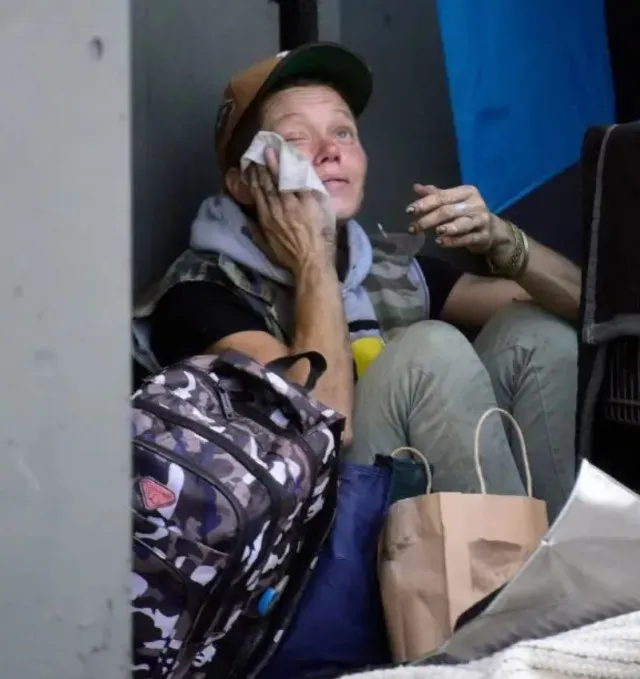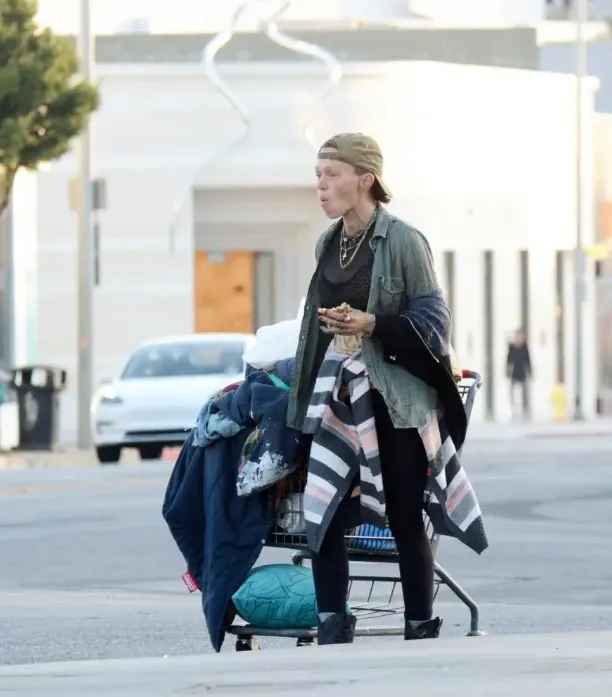Loni Willison, a former fitness model and ex-wife of Baywatch star Jeremy Jackson, once basked in the glamour of Hollywood. With a promising career and a luxurious lifestyle, she seemed to have it all. But over the years, her life has taken a dramatic turn for the worse. Now, she is seen living among garbage on the streets of Los Angeles, grappling with mental health issues, homelessness, and substance abuse.
Loni Willison: From Fitness Fame to a Troubled Life

Loni Willison rose to fame as a fitness model, gracing magazine covers and enjoying the high life in Hollywood. Her journey into the spotlight was fueled by her dedication to fitness and wellness, which made her a recognizable face in the industry. However, beneath the glamorous exterior, her personal life was fraught with turmoil.
The Dark Turn in Loni’s Life
Loni’s personal struggles began to escalate after her marriage to Jeremy Jackson. The couple tied the knot in 2012, but their relationship was anything but stable. In 2014, after two tumultuous years together, their marriage ended amid a shocking incident where Loni accused Jackson of attempting to strangle her during a drunken argument. The altercation left her with broken ribs and a neck injury.
Despite her injuries, Loni chose not to press charges against Jackson, fearing the emotional consequences and legal battles. “I was scared,” she later admitted. “I didn’t want Jeremy to go to jail.” The traumatic experience, compounded by the challenges of divorce, sent her into a downward spiral.
The Descent into Homelessness and Addiction
After her marriage collapsed, Loni’s mental and physical health deteriorated rapidly. Unable to work due to her emotional instability, she struggled to pay her bills and was eventually evicted from her home in 2016. This marked the beginning of her life on the streets of Los Angeles.
Living in Dire Conditions on the Streets of LA
Loni’s current living conditions are heartbreaking. She is often seen pushing a shopping cart filled with her belongings, rummaging through trash bins for food, and huffing paint from paper bags. Her physical appearance is a stark contrast to her days as a fitness model. Once a vibrant and healthy individual, Loni now looks frail, with visible injuries, missing teeth, and a severely emaciated frame. She is nearly unrecognizable from her former self.
Loni has been living on the streets for nearly seven years, mostly seen in Santa Monica. Her presence on the streets, often marked by short hair, bruises, and worn-out clothing, paints a bleak picture of the devastating effects of addiction and homelessness.
Mental Health Struggles: A Barrier to Recovery

Loni’s mental health challenges have played a significant role in her current state. After her divorce, she experienced a severe mental breakdown, which was further complicated by her battle with substance abuse.
Delusions and Paranoia
Loni’s struggles are not limited to her living conditions. She has openly spoken about her delusions, particularly her belief that she was tortured through electric currents in her apartment, which has left her unable to live indoors. She claims that she has developed heightened sensitivity to electricity and chemicals, making it impossible for her to stay in stable housing.
Loni explained, “I think because [I pick] up on the electricity, I also pick up on other things, like certain chemicals, batteries, or fuses… even different types of metals. My body filters that kind of stuff.” These delusions have only exacerbated her refusal to accept help, keeping her trapped in a cycle of homelessness.
Attempts to Help Loni: A Continuous Struggle

Despite Loni’s dire circumstances, various individuals and organizations have attempted to offer her support. Friends, former colleagues, and drug rehabilitation specialists have all tried to intervene, offering free rehabilitation and sober living facilities.
Repeated Refusal of Assistance
Even with numerous offers of help, Loni has consistently refused to accept long-term support. In one instance, a specialist provided her with a spot in a sober living home at no cost. However, she left after just 24 hours, returning to her life on the streets.
Loni has mentioned that she is “fine” living as she does and feels no need for others to intervene. While this perspective offers a glimpse into her mental state, it also leaves those who care about her deeply concerned about her safety and well-being. Despite the urgency of her situation, she remains steadfast in her decision to live without assistance.
Substance Abuse: A Devastating Factor

One of the most troubling aspects of Loni’s life on the streets is her ongoing substance abuse. In recent sightings, she was observed huffing paint from a can of Rust-Oleum paint primer, highlighting the severity of her addiction.
The Health Risks of Huffing Paint
Huffing paint, a form of substance abuse involving inhaling toxic chemicals, can have severe and long-term health consequences. It damages the brain, heart, and other organs, often leading to a rapid decline in both physical and mental health. For Loni, this addiction has contributed significantly to her deteriorating condition, making it even harder for her to break free from the cycle of homelessness.
A Heartbreaking Contrast: Then vs. Now
The contrast between Loni’s life as a successful fitness model and her current existence on the streets of Los Angeles is stark. She once lived a life filled with opportunity, success, and promise. Now, she struggles for survival, facing the harsh realities of addiction, mental health issues, and homelessness.
The Unfulfilled Hope for Recovery
Loni’s story is one of unfulfilled potential and a desperate need for intervention. While her journey has been marked by personal tragedies and missed opportunities, it also serves as a sobering reminder of the complexities of mental health and substance abuse.
Conclusion: The Ongoing Crisis of Homelessness and Mental Health

Loni Willison’s story is a tragic example of how quickly life can change when mental health issues and addiction go untreated. Her fall from fitness model to homeless woman living on the streets of Los Angeles highlights the urgent need for more accessible mental health care and addiction recovery programs. Despite her refusal to accept help, the persistence of those trying to reach her offers a glimmer of hope.
As Loni continues to navigate the challenges of her reality, her story serves as a heartbreaking reminder of the many others who face similar struggles. It is a call for compassion, awareness, and action, as society grapples with the larger issues of homelessness, mental health, and addiction.


